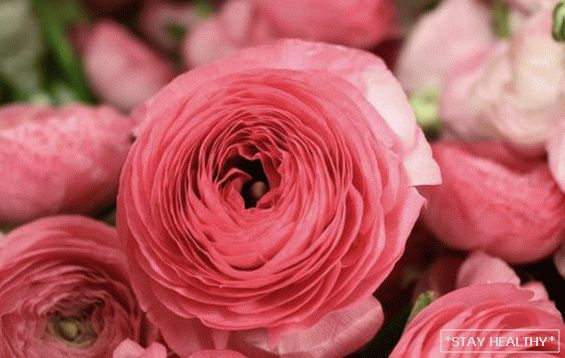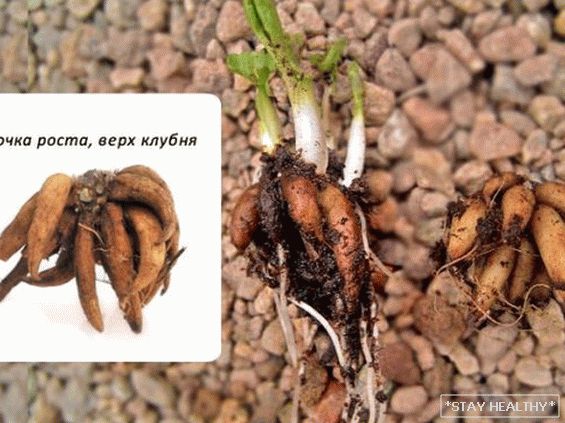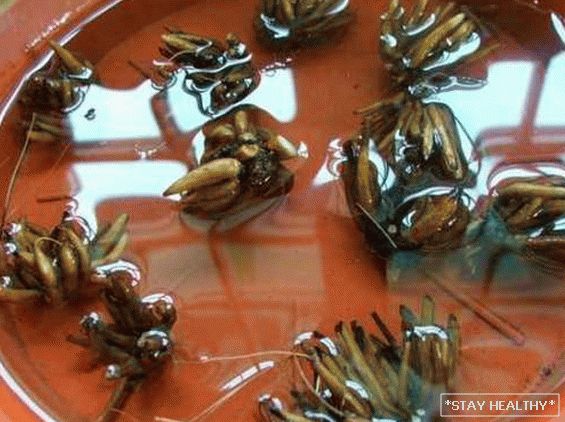 Пт, 29 июл 2016 Автор: Эльвира Корчагина
Пт, 29 июл 2016 Автор: Эльвира Корчагина
Ranunkulyus (buttercup garden, buttercup Asian) – spectacular and bright
a flower that will decorate any garden plot.
This plant has several varieties that
conditionally divided into 2 groups:
• Asian (Persian) ranunculus (its flowers resemble
miniature roses);
• African or halid (inflorescences look like terry
peonies).
Variety of color palette, long flowering period and
unpretentiousness allow to plant a garden buttercup as on beds, so
and grow indoors. In cutting it keeps fresh
up to 2 weeks.
Contents
Ranunkulyus: landing (photo)
The landing site for the ranunculus should be chosen from the shade and
protected from cold winds. With this arrangement, color
flowers will be more vivid, and the flowering itself is long.
The soil for this plant needs light and fertile with
neutral pH. Garden buttercup does not tolerate stagnant moisture in the soil –
its roots quickly rot. Therefore, if selected for landing
loam predominate in the area,
�“Refine” – add compost or rotted manure and
sand.
Plant ranunculus can be 2 ways: seeds and tubers. Sow
seed directly to the ground is recommended only in the southern
regions. In areas with a cooler climate, grow first
seedlings in greenhouses or home conditions, and after passing
spring frosts saplings transplanted to the garden.
When buying ranunculus tubers, you should carefully examine them:
they should not be lethargic, overdried.
Tubers can be planted at the end of April and until the second decade of May (in
depending on the climatic conditions of your region).
They are preliminarily kept for 8-10 hours in a wet substrate.
(sawdust, peat, moss) or simply in water with the addition of potassium permanganate and
growth stimulator. For the prevention of fungal infection of tubers
diseases, it is recommended to treat them with fungicides (for example,
Fundazol, Gamair).
On a prepared bed at a distance of 0.1-0.15 cm from each other
make holes 5-8 cm deep. Put small holes on the bottom of the hole.
mound of the earth, put on it the tubers of the ranunculus (“fingers”
down) and fall asleep ground. Sprouts appear in 1-2 months.
Ranunkulyus planted “fingers” down – the point of growth should
stay on top

Ranunculus: cultivation features (photo)
Seed method of cultivating ranunculus is fraught with risk
failures – the seeds of this flower quickly lose their germination,
especially if stored improperly. Buying seeds in a store,
It is important to pay attention to the expiration date. It’s easier to collect seeds
directly from the first faded flowers, wrapping them
pre-gauze to prevent seed rains on the ground.
Before sowing, seeds are stored in a dry place at + 17-22 degrees.
For growing seedlings in mid-February, seeds are sown in
containers with loose fertile soil. Cover with glass
or film and put in a well-lit place at + 15-17 degrees.
For additional illumination it is good to use fitolamps. The earth
periodically moisturize, remove condensate from the glass. Shoots
will appear in 14-20 days. From this moment the shelter is removed. After
the emergence of the seedlings of two pairs of these leaves spend picking
in separate pots.
Seedlings are ready for picking – they have 2 pairs
leaflets

Plants are planted in a permanent place when the threat is past
frosts. Seedlings bloom only next year.
A feature of growing a ranunculus is that it is
the plant does not tolerate transplants, so you should immediately determine
his permanent place of residence.
Ranunklyus: care (photo)
Care of a ranunculus is not difficult and comes down to watering, loosening,
weeding, fertilizing.
Water the beds with Asian buttercups every 2-3 days. it
the plant loves to “drink some water”, but at the same time does not tolerate it
excess – its tubers are prone to damage by various rot. If a
a white bloom appeared on the leaves, the buds began to fall off, this is a signal
about waterlogging. However, with a lack of moisture ranunculus
also suffers: leaves are covered with reddish spots, decrease
the size of the buds, and they themselves quickly die off in the half-opened
condition. Particularly important timely watering during active
vegetation (with a lack of moisture, these flowers die quickly).
Due to the tendency of the ranunculus tubers to rotting the soil on
flower bed must be loosened every week to provide access
oxygen to the roots.
Garden buttercup is responsive to dressing. Liquid Mullein (1:10)
plants are fertilized during active growth. Before flowering make
complex mineral fertilizers with a high content of potassium and
phosphorus (40-50 g / m2).
After отцветания соцветия удаляют (кроме тех, которые оставлены
for seeds). it стимулирует образование новых цветоносов и
prolongs the decorativeness of plants.
In the autumn after the leaves die off
digging, as they are not winter-hardy. Dug tubers cleaned from
land, soak 30 minutes in solution of potassium permanganate or fungicide
(for example, Fundazol) and left to dry for 2-3 days in a dry
ventilated place.
Ranunculus tubers are soaked in fungicide before storage
solution

Tubers prepared in this way are stored in paper bags in
Refrigerator or in boxes with sand, dry sawdust in a cool
the room at + 10-15oS. In the southern regions with warm winters (down to -3 ° C)
tubers can be left to winter in the ground, covering the beds with spruce branches or
dry foliage.
Ranunculus Diseases and Pests
Ranunculus is less susceptible to disease. However, at
excessive watering on the leaves and peduncles may appear white or
gray bloom, and the roots begin to rot. The plant can fold
buds. In this case, the quantity and volume should be reduced.
watering.
Among the pests for ranunculus, nematodes are dangerous – small (up to 2
mm) worms, parasitic on all parts of plants. Harm caused
both adult insects and their larvae. With the defeat of gallic
(root) nematodes are stunted, wilted and
russeting foliage – the plant looks faded. Detect pest
you can dig up a flower – ugly growths will be visible on the roots
(Gauls). To get rid of the parasite, the roots of the ranunculus are dipped
in hot water (+ 50-60 degrees), and for the destruction of nematode eggs
dive time increased to 30 minutes.
In dry summer, ranuncluus may be affected by spiderwebs.
mites that feed on plant sap. In the field of bites on
leaves appear yellow dots. As tick parasites
dead tissue areas increase, leaves turn prematurely yellow
and fall off. Acaricides are used to combat this pest.
(Akarin, Fitoverm, Aktellik, Agravertin, Vertimek. Fufanon). Their
need to alternate, as the mites quickly produce
resistance to the drugs used. Processing is carried out
several times at certain time intervals (according to
instructions for the drug)
If a на листьях появились серебристые пятна, штрихи. stripes
then thrips feeding on cell sap
plants.
Thrips on the sheet

Поврежденная ткань отмирает, листья вянут and fall off.
Damaged buds, if opened, the flowers are obtained
deformed. Thrips move easily from the affected plant.
on neighboring healthy, so they are difficult to completely destroy For
This is used insecticides (Karate, Aktara, Vertimek, Biotlin,
Spark, Inta-vir and others). The processing of plants is carried out by several
times with an interval of 7-10 days. From folk remedies use
Various herbal infusions, such as:
• 40-50 g of dandelion roots chop and pour 1 liter of warm
water infuse 4-5 hours;
• 50-60g marigolds insist 3 days in 1 liter of warm water. Before
using the infusion strain;
• 80-100 g of tobacco leaves pour water (1 l), infuse 24
hours Before использованием разбавить 1:2.





